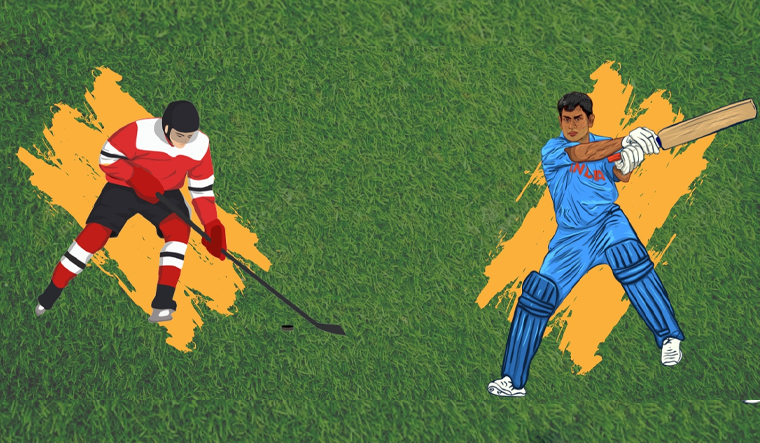India’s love for sports runs deep, but there’s a unique paradox where the national game, hockey, has been overshadowed by cricket. Despite hockey’s glorious past, cricket has emerged as the dominant sport, drawing massive crowds, corporate investments, and international recognition.
Historical Context of Hockey in India
The golden era of Indian hockey stretched from 1928 to 1956, during which India won six consecutive Olympic gold medals. Legends like Dhyan Chand became national icons. Hockey, supported by state patronage, was a source of pride. However, post-Independence, the sport struggled with mismanagement, and its decline became evident in the 1970s and 1980s. The introduction of artificial turf on the international stage posed significant challenges for India, which still relied on natural grass. Additionally, bureaucratic mismanagement, lack of infrastructure, and inadequate international exposure contributed to the sport’s diminishing success.
Emergence of Cricket in India
Cricket was introduced to India by British colonizers in the 18th century, and the Parsis were the first Indian community to embrace the game. India’s participation in international cricket began in 1932, but the sport truly began to take off post-Independence. The 1971 cricket series wins against the West Indies and England became turning points, transforming cricket into a symbol of national pride. The Board of Control for Cricket in India (BCCI), formed in 1928, structured the administration of cricket far more efficiently than the Indian Hockey Federation (IHF) could manage hockey.
Reasons for Cricket’s Popularity Over Hockey
Media and Broadcasting Revolution
Cricket’s popularity surged after India’s historic win at the 1983 Cricket World Cup. The advent of television in the 1980s brought live cricket matches into homes across the country, elevating the sport’s visibility. During the 1990s, economic liberalization and the rise of private television channels like Star Sports and ESPN gave cricket even greater exposure. Cricket’s long format also allowed for commercialization through advertisements, sponsorships, and celebrity endorsements—something hockey struggled to achieve.
Sponsorship and Corporate Investments
Cricket became the top choice for corporate sponsorships. Companies like Pepsi, Coca-Cola, and later Paytm heavily invested in the sport. BCCI monetized broadcasting rights and sponsorship deals, building a financial empire that hockey could not compete with. The launch of the Indian Premier League (IPL) in 2008 further cemented cricket’s dominance. The IPL’s shorter T20 format became a massive crowd-puller, turning cricketers into celebrities and making the sport even more commercially viable.
Cultural and Social Aspects
Cricket grew into a national symbol of unity, transcending regional and class boundaries. The diversity of the Indian cricket team reflected the nation’s diversity, and major tournaments like the World Cup fostered national fervor. Cricket legends like Kapil Dev, Sachin Tendulkar, MS Dhoni, and Virat Kohli became household names, revered as heroes. Unlike hockey, cricket could be played almost anywhere, from streets to open fields, making it more accessible to people across India.
Globalization of Cricket and BCCI’s Rise to Power
The BCCI’s financial strength has made it one of the richest sports bodies in the world. It wields immense influence over world cricket, driving key decisions in the International Cricket Council (ICC). India’s international cricket success, along with the global popularity of IPL, has solidified cricket’s position as the nation’s favorite sport. In contrast, Indian hockey struggles to achieve the same level of international exposure.
Fall of Hockey: Challenges and Lack of Popularity

Bureaucratic Mismanagement
While the BCCI effectively governed cricket, the IHF was plagued by corruption, infighting, and inefficiency. Hockey’s administration lacked structural reforms and failed to improve grassroots-level facilities or infrastructure.
Lack of Media Attention
Hockey, unlike cricket, did not receive consistent television coverage. Its inability to cultivate star players or a glamorous image made it less appealing to a media-driven audience. As a result, hockey had limited visibility compared to cricket.
Lack of Infrastructure and Facilities
The shift to artificial turf in international hockey was a significant setback for India, where most hockey grounds remained natural grass. This infrastructural disadvantage, coupled with underfunding at the grassroots level, hampered the development of future players. Meanwhile, cricket academies and stadiums flourished across the country.
Failed Attempts at Revival
The Hockey India League (HIL), launched in 2013, was an attempt to replicate the success of IPL. Unfortunately, it failed to generate the same excitement or financial returns. The league was suspended after 2017 due to financial difficulties, further diminishing hockey’s profile.
Cricket’s Current Dominance in India
India has emerged as a leading cricketing nation, excelling in all three formats—Test, ODI, and T20. The IPL has transformed the sport, placing Indian cricket at the forefront of innovation and commercialization. With unmatched financial strength from broadcasting rights, sponsorships, and international tournaments, the BCCI wields significant influence in global cricket politics.
Although Indian hockey has recently seen a resurgence, highlighted by a bronze medal at the 2020 Tokyo Olympics, cricket continues to dominate in popularity, media attention, and corporate investment.
Conclusion
Cricket’s rise in India is the result of multiple interconnected factors, including media attention, strategic marketing, corporate investment, and efficient governance. Hockey, on the other hand, has suffered from poor management, inadequate infrastructure, and limited media exposure. While efforts to revive hockey continue, cricket’s dominance seems insurmountable, given its deep-rooted presence in Indian society, bolstered by strong financial backing and widespread fan support. As long as the BCCI and IPL continue to innovate and set new standards for sports entertainment, cricket’s position as India’s premier sport is likely to remain unchallenged.










